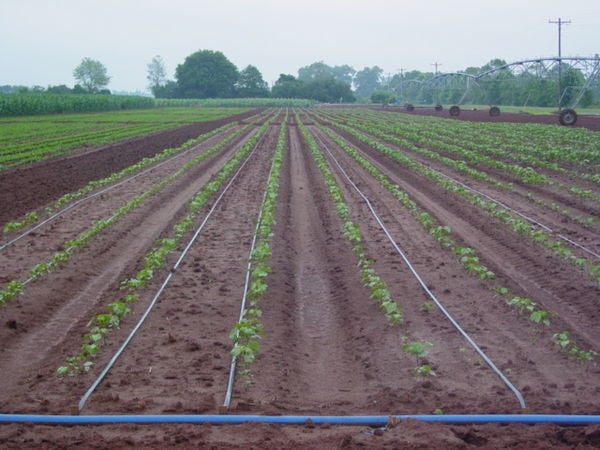
Drip irrigation is irrigation through small tubes targeted to the roots of the plant. It is the most common form of micro irrigation.
It is low pressure and low volume irrigation.
Method
Small horizontal pipes are laid on the ground or just below the surface.
These are connected to a water supply, and slowly drip water.
Very simple appropriate technology methods exist, using simple equipment and gravity feed.
Context
Due to setup and maintenance costs, it is most suitable for high value crops - e.g. fruits and vegetables, rather than grains.
Benefits
The benefits are significant improvements in water efficiency, and yield increases - which seems to be the case regardless of the type of crops.[1]
Additional benefits include:
- Water is distributed relatively uniformity.
- Water-soluble fertilizer may be injected through a microirrigation system.
- Sloping or irregularly-shaped land areas can be irrigated - where flood irrigation is unsuitable.
- It may reduce labor requirements, where labor is otherwise needed for irrigation.
If you look closely you'll see the Drip irrigation is one of the more advanced techniques being used today because, for certain crops, it is much more efficient than traditional spray irrigation, where a larger portion of the water is lost to evaporation.
In drip irrigation, water is run through pipes (with holes in them) either buried or lying slightly above the ground next to the crops. Water slowly drips onto the crop roots and stems. Unlike spray irrigation, very little is lost to evaporation and the water can be directed only to the plants that need it, cutting back on water waste.
Notes and references
See also
- Drip Irrigation Helps Farmers Save Money
- Drip Irrigation Turns Gravel into Green
- CCAT Gravity fed drip irrigation
- Drip line placement
- Micro-irrigation
- Irrigation methods
Interwiki links
External links
- [Solar-powered drip irrigation enhances food security in the Sudano–Sahel] Jennifer Burney, Lennart Woltering, Marshall Burke, Rosamond Naylor, and Dov Pasternak, Proceedings of the National Academy of Sciences of the United States of America, 2010 February 2.</ref>
- ↑ Subsurface drip irrigation of row crops: a review of 15 years of research at the Water Management, Research Laboratory, USDA, 22 December 1998.